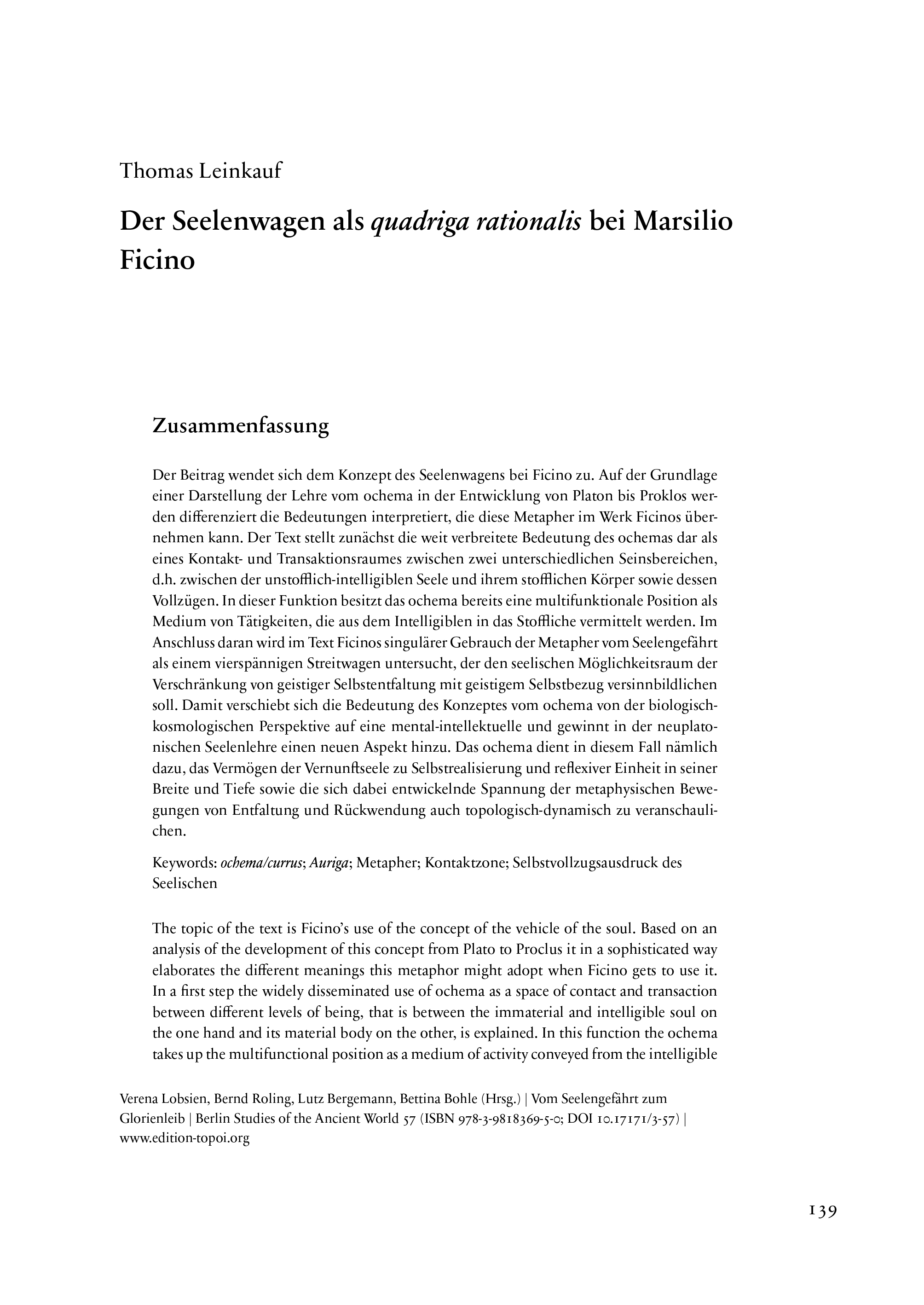Der Seelenwagen als quadriga rationalis bei Marsilio Ficino
The topic of the text is Ficino’s use of the concept of the vehicle of the soul. Based on an analysis of the development of this concept from Plato to Proclus it in a sophisticated way elaborates the different meanings this metaphor might adopt when Ficino gets to use it. In a first step the widely disseminated use of ochema as a space of contact and transaction between different levels of being, that is between the immaterial and intelligible soul on the one hand and its material body on the other, is explained. In this function the ochema takes up the multifunctional position as a medium of activity conveyed from the intelligible into the material realm. Secondly the text analyses Ficino’s unique usage of the ochema metaphor as a war-chariot drawn by four horses. This according to the thesis of this paper shall illustrate the space of capability the soul possesses according to its capability of noeric self-explication and noeric-self-reference. Thus the meaning of the ochema-concept shifts from the cosmological to the mental-noeric and therefore gains a new aspect of meaning in the context of the neoplatonic doctrine of the soul. Namely it is used to explain the rational soul’s special capability of self-realization in reflexive unity in all its breadth and depth as well as to illustrate in a topological as well as a dynamic way the tension of the metaphysical kinetics of explication/progression and reversal.
Der Beitrag wendet sich dem Konzept des Seelenwagens bei Ficino zu. Auf der Grundlage einer Darstellung der Lehre vom ochema in der Entwicklung von Platon bis Proklos werden differenziert die Bedeutungen interpretiert, die diese Metapher im Werk Ficinos übernehmen kann. Der Text stellt zunächst die weit verbreitete Bedeutung des ochemas dar als eines Kontakt- und Transaktions-raumes zwischen zwei unterschiedlichen Seinsbereichen, d.h. zwischen der unstofflich-intelligiblen Seele und ihrem stofflichen Körper sowie dessen Vollzügen. In dieser Funktion besitzt das ochema bereits eine multifunktionale Position als Medium von Tätigkeiten, die aus dem Intelligiblen in das Stoffliche vermittelt werden. Im Anschluss daran wird im Text Ficinos singulärer Gebrauch der Metapher vom Seelengefährt als einem vierspännigen Streitwagen untersucht, der den seelischen Möglichkeitsraum der Verschränkung von geistiger Selbstentfaltung mit geistigem Selbstbezug versinnbildlichen soll. Damit verschiebt sich die Bedeutung des Konzeptes vom ochema von der biologisch-kosmologischen Perspektive auf eine mental-intellektuelle und gewinnt in der neuplatonischen Seelenlehre einen neuen Aspekt hinzu. Das ochema dient in diesem Fall nämlich dazu, das Vermögen der Vernunftseele zu Selbstrealisierung und reflexiver Einheit in seiner Breite und Tiefe sowie die sich dabei entwickelnde Spannung der metaphysischen Bewegungen von Entfaltung und Rückwendung auch topologisch-dynamisch zu veranschaulichen.

